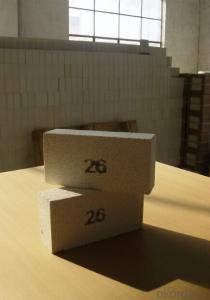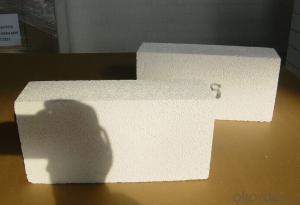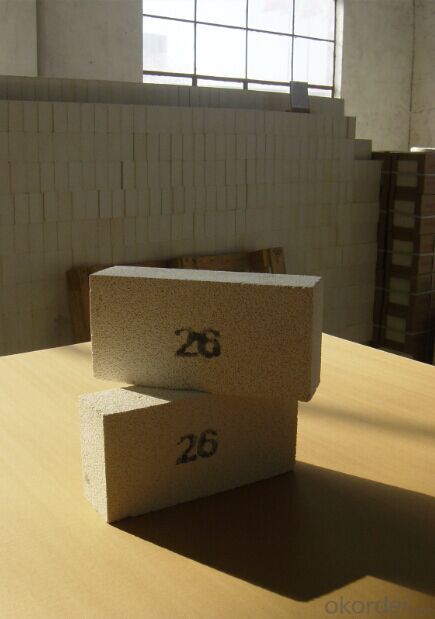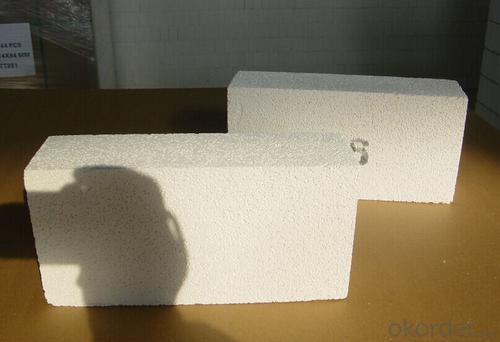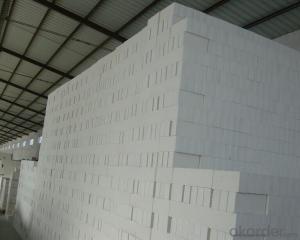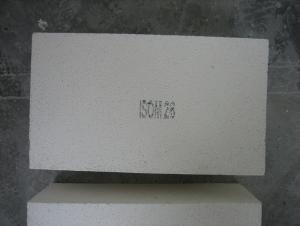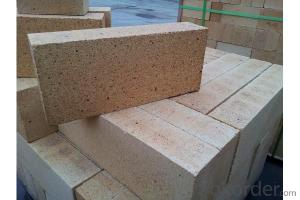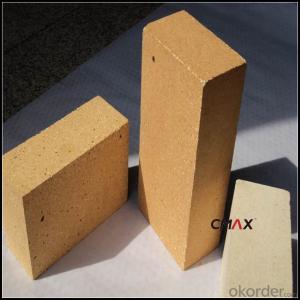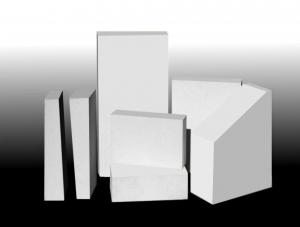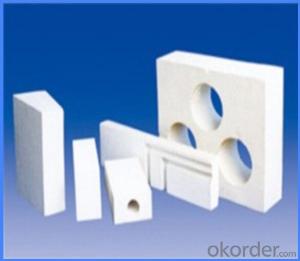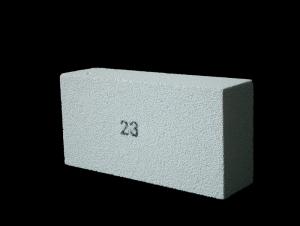High Quality Insulating Fire Brick - Insulation Bricks Refractory 23 26
- Loading Port:
- Shanghai
- Payment Terms:
- TT OR LC
- Min Order Qty:
- 5000 pc
- Supply Capability:
- 50000 pc/month
OKorder Service Pledge
OKorder Financial Service
You Might Also Like
1.Description of Insulation Brick:
CMAX insulating firebricks are classified under temperature between 1100℃ to 1700℃, manufactured from high purity alumina clay..
2.Main features of Insulation Brick:
◆Light weight and low thermal conductivity ◆Low heat storage
◆Low iron and impurities ◆High thermal shock resistance
3. Insulation Brick Images:
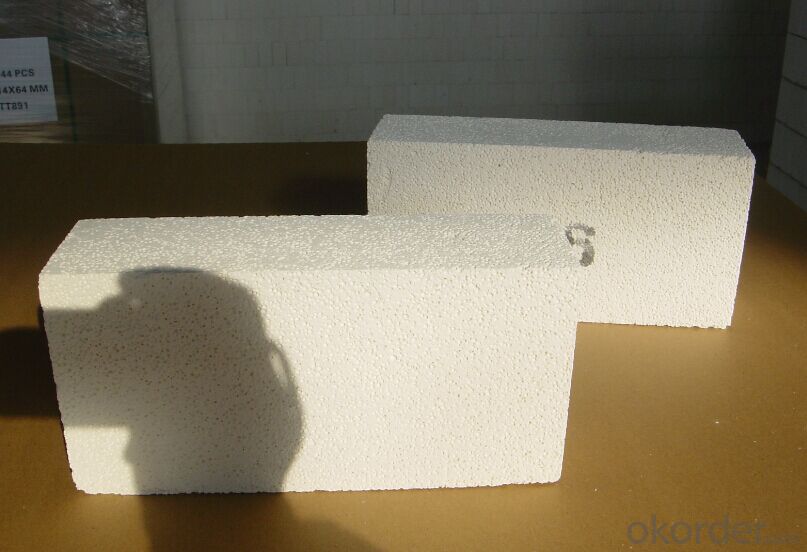
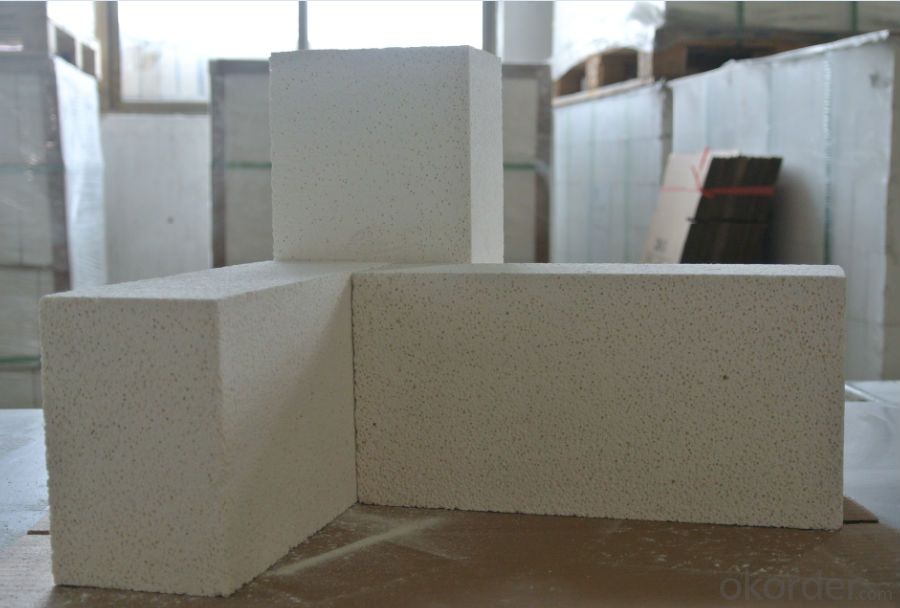
4. Insulation Brick Technical Parameters
Our Insulation Brick contains 20, 23, 25,26, 28, 30, 32. Classification temperature is from 1100℃ to 1760℃. Density is from 0.52g/cm3 to 1.25g/cm3. As we all know, the company type is 23 and 26.
1) For the 23, its density is 0.52g/cm3, but some customer may require 0.8g/cm3, we can also meet your special require. Content of Al2O3 is about 45%.
2) For the 26, its density is 0.8g/cm3, but if you have other special requirement on that, pls also tell us. Content of Al2O3 is about 55%.
Application: CMAX insulating firebricks can be used as a hot face lining directly exposed to the heat or as a backup insulation layer in iron and steel mills, non-ferrous foundries, petrochemical, ceramic, glass. If you need other application picture, please contact with us
5.FAQ
We have organized several common questions for our clients,may help you sincerely:
① How about our Insulation Brick?
A world class manufacturer & supplier of InsulationBrick is one of the large scale professional investment casting production bases in China,consisting of both casting foundry forging and machining factory. Annually more than 8000 tons Precision casting and forging parts are exported to markets in Europe,America and Japan. OEM casting and forging service available according to customer’s requirement.
②How to guarantee the quality of the products?
We have established the international advanced quality management system every link from raw material to final product we have strict quality test; We resolutely put an end to unqualified products flowing into the market. At the same time, we will provide necessary follow-up service assurance.
- Q: Do insulating fire bricks require any special fireproof gaskets or seals?
- No, insulating fire bricks do not require any special fireproof gaskets or seals. Insulating fire bricks are designed to have a high resistance to heat and can withstand high temperatures without the need for additional gaskets or seals. These bricks are typically used in applications such as kilns, furnaces, and fireplaces, where they provide insulation and help retain heat. Their composition and structure allow them to create a barrier against heat transfer, eliminating the need for any additional seals or gaskets. However, it is important to ensure proper installation and alignment of the bricks to ensure a tight fit and maximize their insulating properties.
- Q: Can insulating fire bricks be used in high-temperature filters?
- Insulating fire bricks have the capability to be utilized in high-temperature filters. These bricks are specifically engineered to endure exceedingly high temperatures, typically reaching up to 3000°F (1650°C). They possess remarkable thermal insulation properties, low thermal conductivity, and high resistance to thermal shock, rendering them highly suitable for applications involving elevated temperatures. In the context of high-temperature filters, insulating fire bricks can be employed to construct the filter's framework, ensuring its endurance against the intense heat generated. These bricks can be arranged in such a manner that enables efficient filtration of gases or liquids while upholding their structural integrity under high temperatures. Additionally, the insulating properties of these bricks aid in minimizing heat loss and maximizing energy efficiency. Furthermore, insulating fire bricks often exhibit chemical inertness and possess commendable resistance to corrosive substances, thus making them appropriate for implementation in various industrial processes that entail the filtration of aggressive or hazardous materials at elevated temperatures. Overall, the utilization of insulating fire bricks in high-temperature filters offers a dependable and long-lasting solution for filtration applications that necessitate resistance to extreme temperatures.
- Q: Are insulating fire bricks resistant to vibration or seismic activity?
- Yes, insulating fire bricks are typically resistant to vibration or seismic activity. They are designed to withstand high temperatures and provide insulation, which also makes them relatively stable and resistant to external forces such as vibrations or seismic activity.
- Q: Can insulating fire bricks be used in the construction of pottery molds?
- Insulating fire bricks are indeed applicable for the construction of pottery molds. Crafted from lightweight refractory materials, these bricks possess exceptional heat insulation qualities. Specifically engineered for high-temperature applications like pottery kilns, they offer a range of benefits. When constructing pottery molds, it is imperative to utilize materials that can endure the kiln's intense heat. Insulating fire bricks can withstand temperatures of up to 3000°F (1650°C), rendering them ideal for pottery mold construction. They provide insulation to prevent heat dissipation and maintain consistent temperatures within the kiln, crucial for achieving the desired firing results. Moreover, insulating fire bricks can be conveniently shaped and cut to suit the designated mold design. Their lightweight nature also simplifies handling during the mold construction process. Additionally, the insulating properties of these bricks curtail energy consumption by preventing excessive heat loss, making them a cost-effective choice in the long term. All in all, insulating fire bricks prove to be a fitting option for constructing pottery molds due to their capacity to withstand high temperatures, offer insulation, and be easily molded to meet specific design requirements.
- Q: Can insulating fire bricks be used in ceramic industry kilns?
- Yes, insulating fire bricks can be used in ceramic industry kilns. These bricks are designed to withstand high temperatures and provide excellent insulation, making them suitable for use in kilns where high heat retention and energy efficiency are important.
- Q: Are insulating fire bricks resistant to oil or chemical spills?
- Yes, insulating fire bricks are resistant to oil or chemical spills. These bricks are designed to withstand high temperatures and are made from materials that are chemically inert, which makes them highly resistant to the corrosive effects of oil or chemicals. This property makes insulating fire bricks an excellent choice for applications where exposure to oil or chemical spills is expected.
- Q: Do insulating fire bricks require a protective coating for outdoor use?
- Insulating fire bricks are specifically designed to withstand high temperatures and provide thermal insulation. While they are commonly used in indoor applications such as kilns, furnaces, and fireplaces, they can also be utilized for outdoor purposes. However, whether insulating fire bricks require a protective coating for outdoor use depends on the specific circumstances and environment in which they will be employed. In general, insulating fire bricks are made of materials like clay or alumina silicate, which possess inherent resistance to weathering and environmental factors. They can endure exposure to rain, snow, and even extreme temperatures without significantly deteriorating. These bricks are often classified as refractory materials due to their ability to withstand heat, making them highly durable in outdoor settings. Nevertheless, there may be certain situations where it is advisable to apply a protective coating to insulating fire bricks for additional safeguarding. For instance, if the bricks will be continuously exposed to harsh weather conditions, prolonged UV radiation, or corrosive substances, a protective coating can enhance their longevity. The choice of coating will depend on the specific requirements and expected conditions. Various options are available, including high-temperature paint, ceramic coatings, or silicone-based sealants. These coatings can provide an extra layer of protection against moisture, chemicals, and temperature fluctuations, ensuring the bricks maintain their insulation properties and structural integrity over time. In summary, insulating fire bricks are generally suitable for outdoor use without requiring a protective coating, as they are specifically designed to withstand high temperatures and adverse weather conditions. However, if the bricks will be exposed to particularly harsh or corrosive environments, applying a suitable protective coating can provide additional durability and ensure their longevity. It is always recommended to consult with experts or manufacturers for specific guidance based on the intended use and outdoor conditions.
- Q: Can insulating fire bricks be used for structural purposes?
- Insulating fire bricks are primarily designed to provide insulation rather than structural support. While they can withstand high temperatures and are resistant to thermal shock, they are not typically intended to bear heavy loads or serve as load-bearing components in structural applications. Insulating fire bricks are more commonly used in situations where thermal insulation is required, such as lining kilns, furnaces, and fireplaces. For structural purposes, it is generally recommended to use refractory bricks or other materials that are specifically engineered to provide strength and durability under load.
- Q: Are insulating fire bricks suitable for use in lime kilns?
- Insulating fire bricks are indeed a suitable option for utilization in lime kilns. Lime kilns function at elevated temperatures, usually ranging from 900 to 1200 degrees Celsius. These insulating fire bricks are specifically constructed to endure such extreme temperatures and offer exceptional thermal insulation. With their low thermal conductivity, they aid in conserving heat and upholding high temperatures inside the kiln. Moreover, these bricks possess a lightweight nature and exhibit considerable resistance to thermal shock, rendering them ideal for the cyclic heating and cooling procedures employed in lime kilns.
- Q: Can insulating fire bricks be used for high-temperature insulation?
- Absolutely, high-temperature insulation can be achieved with the use of insulating fire bricks. These bricks are specifically engineered to endure and provide insulation against elevated temperatures, making them exceptionally suitable for a wide range of high-temperature applications. Constructed from lightweight refractory materials, these bricks exhibit remarkable thermal conductivity properties, effectively capturing and hindering heat transfer. They find extensive utilization in furnaces, kilns, ovens, and other heating apparatuses that necessitate insulation against extreme temperatures. Capable of withstanding temperatures as high as 3000°F (1650°C), insulating fire bricks offer a dependable solution for high-temperature insulation requirements.
Send your message to us
High Quality Insulating Fire Brick - Insulation Bricks Refractory 23 26
- Loading Port:
- Shanghai
- Payment Terms:
- TT OR LC
- Min Order Qty:
- 5000 pc
- Supply Capability:
- 50000 pc/month
OKorder Service Pledge
OKorder Financial Service
Similar products
Hot products
Hot Searches
Related keywords
